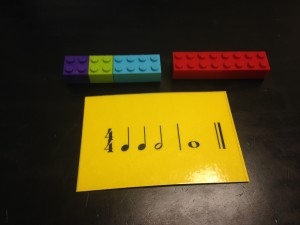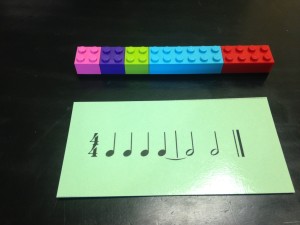Last week I posted about a studio-wide project a started with legos, read more about it here: Legos in the Piano Studio – Part 1 of 2. If you’re wondering how the lego sculpture is coming along, here it is today:

The kids have been having a lot of fun adding to the sculpture each week, I even suspect some have practiced extra so that they can add an extra lego block to the sculpture (success!).
I promised another post about how to use legos for rhythms in your studio, so here we go! I have loved using legos as a manipulative to help students understand rhythms. I find that students who don’t truly understand the rhythms are hesitant to count aloud while they clap a rhythm, but once I start using legos as visual representations of the rhythms they start to really get it and count aloud with gusto. Here’s how I do it:
I start with two black 2×8 blocks like this. These represent two empty measures.

Then, I show them how to make a simple rhythm (using Joy’s rhythm cards) with the legos and we clap and count aloud. See how each quarter note is a 2×2, the half note is double in length, and the whole note is double that, taking up the whole 2×8 lego, otherwise known as a measure.
After I have shown them one simple rhythm they all seem to understand pretty easily. I give them a few more simple ones and then start to throw in some curveballs, such as the rhythm with quarter rests below. I love to give them a card with something new and see if they can figure out how to do it themselves, and usually they can! The quarter rests work so well in the lego rhythms because they can see how the rest actually takes up space but is “empty.” This is a quick way to fix the misconception that a rest gets 0 beats, which drives me crazy.
Another curveball I like to through them is a tie over a bar-line. My students have been very good at figuring out this one too. I think it is great how they can easily see the duration of the note and it connects over our two black measure legos, really helps them to visualize this concept.
Eighth-notes can be created with the 1×2 legos, and syncopation becomes easy to see as well, as seen in the rhythm below.
Of course there are limits to how far we can go with this (I have no idea how I would do triplets) but for basic rhythms including eighth-notes, rests, syncopation, and ties these work great. I had seen ideas where teachers actually wrote the notes on the legos, but I think that is unnecessary. Students understand the note values very quickly. If you wanted to work with 3/4 rhythms you could simply start with a 2×6 lego for the base instead of the 2×8.
I hope this helps your students improve their understanding of rhythms and adds some extra fun to rhythm counting in your studio!
Author: Spring
Spring Seals, NCTM, teaches 60 piano students ranging from age 3 to 70 in Fort Worth, Texas. She also serves as the Director of Certification for TMTA. She is passionate about helping teachers become more effective in their studios through professional development, new resources, and fresh ideas.




